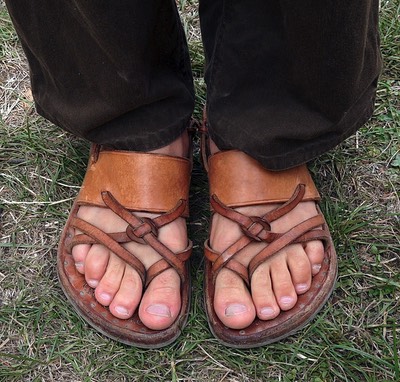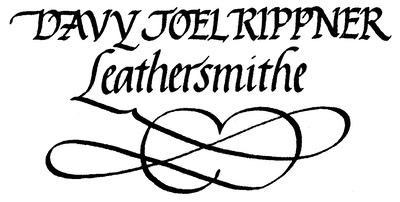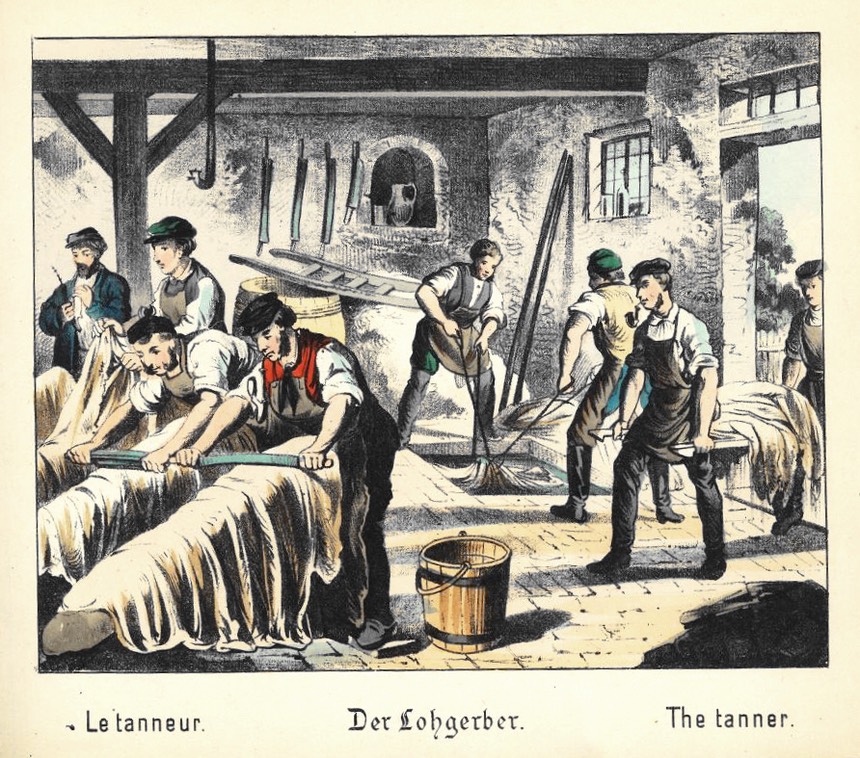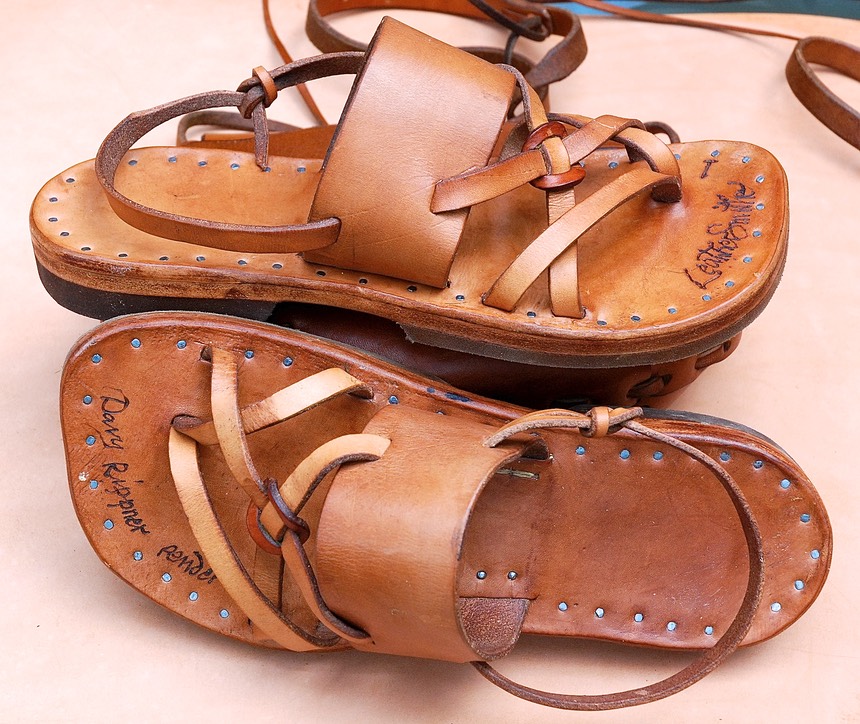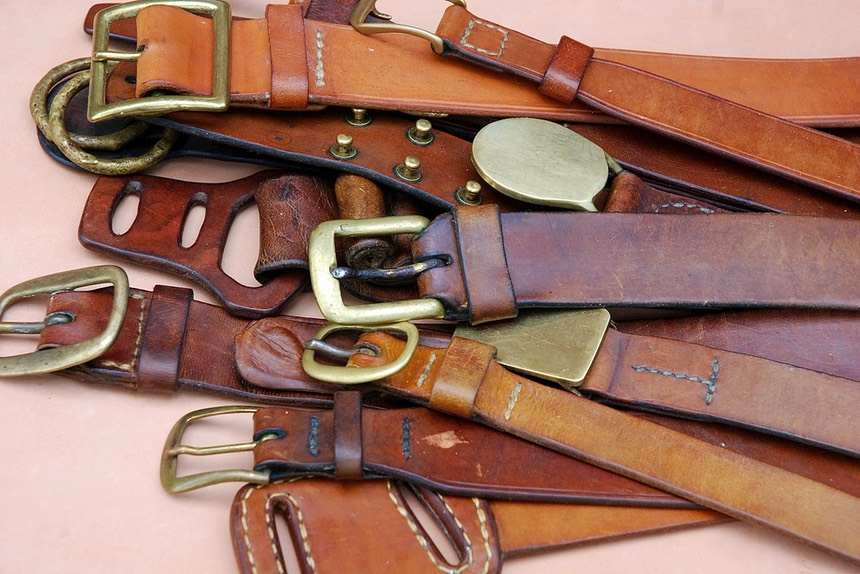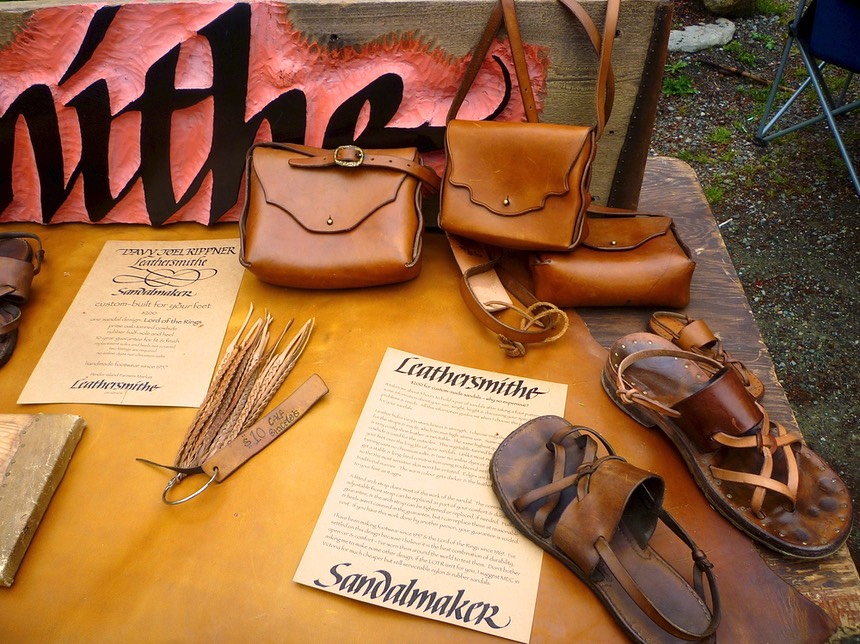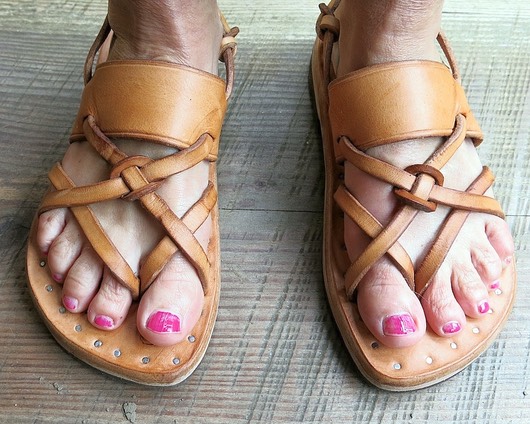
LotR - Lord/Lady of the Rings – original design 1967 by Leathersmithe. The leather rings and continuous slim straps allow you to make on-the-go adjustments for fit & comfort.
Build your own LotRs
Sheet Bend Knot - Used to secure straps on Leathersmithe sandals in place of metal buckles or other disimilar-material devices. Minimalist, self-securing, infinitely-adjustable & elegant fastening solution.
Ranger button – Variations of this simple device are found in most traditional hide-using cultures. I first saw this form in 1961 used by Western Native-American cowboys to hold their Levi jackets open a few inches for ventilation, but securely enough to protect them in the bush or for a fall. I use them for bracelets and to affix pouch flaps.
Burnished –
Leather edges of sandals, straps, wallets and pouches that have been hand-rubbed with saddle soap and dubbin, so that the fibers are packed into place, resulting in a smooth protective surface without the need of dye or hardeners.
Fleshing – A
mechanical operation that rids the hides of excess flesh, fat, and
muscle found on the inside (flesh side) of the hides.
Curing – The treatment of raw hides and skins after flaying to retard bacterial action and putrefaction.
Flesh curing – Hides are washed and salted individually. This is accomplished by spreading out first one hide, hair side down, on a concrete floor. The flesh side is then sprinkled with a generous coating of granular salt. Then a second hide is placed hair-down upon the first, and likewise treated with salt. This procedure is repeated until piles up to eight feet high are formed. The salted hides are left to cure for several days, during which time the salt granules dissolve in the skin moisture and thoroughly penetrate the hide.
Brine curing – Brine curing is the faster method of salt treatment. The washed hides are placed in large vats called raceways to which is added a concentrated salt solution (brine). Mechanical means are provided to cause the hides to swim around in the brine, and complete penetration of the salt solution into the hide is accomplished in about 12 hours. Treated hides are removed from the brine-filled raceway, allowed to drain, dry salt is sprinkled on them, and they are bundled for shipment.
Rawhide – This is the usual North American term, which has spread largely to other English-speaking countries, for cattlehide that has been dehaired and limed, often stuffed with oil or grease, and has sometimes undergone other preparatory processes, but has not been tanned. Some rawhide has the hair left on.
Oak-tanned or vegetable-tanned cowhide – Slow, traditional tanning method using oak bark and non-chemical agents. Used for saddlery, belts and Leathersmithe sandals because of it's maleability, beauty, strength and durability. Must be conditioned and maintained using saddle soap and dubbin. Watch a 20 minute video tour of the Hermann Oaks© St. Louis tannery. See Across the Atlantic in a Leather Boat
Is it really vegetable-tanned? Here is how you can tell: Vegetable-tanned leather has a shrinkage temperaruture of approximately 75 C. The boiling point of water is 100 C. Leather which is tanned with chrome only, such as garment leather, will have a shrinkage temperature of approximately 110 C. If the leather is combination-tanned, (chrome and vegetable) the shrinkage temperature may be under 100 C, but certainly much higher than that of vegetable-tanned leather.
Latigo – See Combination-tanned, below.
Chrome-tanned cowhide – Tannage of leather with chromium compounds; sometimes with small amounts of some other tanning agent, but not enough to alter the chrome-tanned character of the leather.
Harness, belting, and bridle leather – Traditional oak-tan or re-tanned full grain cowhide used for equestrian and farm-animal tack or traces. Used for Leathersmithe sandal insoles, outersoles and all straps.
Combination-tanned – Leather, such as latigo, that is initially chrome-tanned and dyed and then re-tanned using a combination of alum, gambier, vegetable extracts, and "stuffed" with parafin wax, oils and/or fats.
Re-tanning – The process wherein products (such as parafin in latigo) are introduced in a chrome-tanning following an initial vegetable-tanning that produces the ultimate character of the leather.
Fat-liquored – A re-tanned hide that has undergone nourishing with a blend of emulsified fats and/or oils.
Wet-Stuffing – The impregnation of leather through the introduction of a rich blend of emulsifiable oils. This is an intermediate step between fat-liquoring and hot-stuffing.
Hot-stuffing – The tannery process of impregnating leather (i.e. latigo) with wax, oils and/or fats that are solid at room temperature.
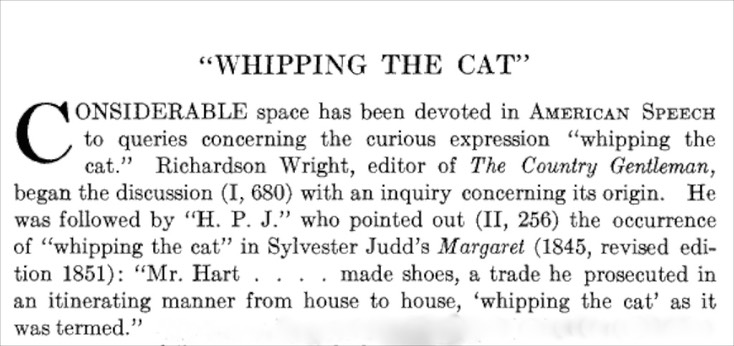
Whipping the cat — in colonial America itinerant shoe makers traveled from farm to farm, making shoes for the family out of the farm's tanned hides, for a fee plus room and board.
Side – Half a whole hide, cut longitudinally.
Split – A term used to describe the under portion of a hide or skin, split into two or more thicknesses. Under rulings of the US Federal Trade Commission, a split must be so marked and cannot be called "genuine leather" or "genuine cowhide."
Grain – The outer or hair side of a hide or skin. Also the pattern of the outer surface after the hair or wool and epidermal tissue have been removed.
Full-grain – A leather type that has not undergone buffing, sanding, splitting or snuffing. Also referred to as “top-grain.”
Hand-glazed – A leather that has been burnished with a machine called a glazing jack. The machine polishes the surface of the leather with a fixed glass rod.
Mill – A wood or metal drum of varying size that is used in processes such as tumbling, stuffing, retanning, and coloring. In appearance, it looks like a gigantic, rotating barrel.
Tumbled, dry milled – Leather that has been softtened by being run in a mill for a predetermined time.
Weight –
The thickness of leather, measured in ounces or millimeters. Leathersmithe sandal components range from 6 oz. to 12 oz., depending upon their intended purpose, your weight & foot size.
Saddle soap, dubbin — See Care of your Sandals & Saddle-soaping, applying dubbin, repairs
Carnauba wax — The "Queen of Waxes".
Bridle Butt
The Bridle Butt is the premium part of the hide. It has fewer growth marks and is used for straps, belts, soles, saddlery.
Length: 60 inches
Width: 24 inches
Thickness: 4—4.5mm
Bridle Shoulder
The shoulder shows more growth and character of the hide. It is used for straps, insoles.
Length: 40—50 inches
Width: 24—36 inches
Thickness: 2.5—3.5mm
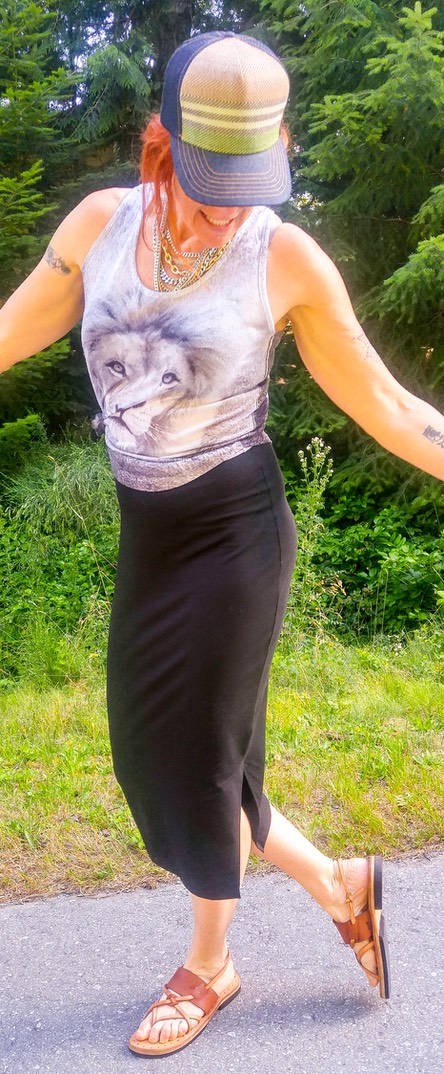
Here’s another glossary, with thanks to Mike Redwood, specialist marketing consultant for the leather industry. http://www.mikeredwood.com/home
Ageing
The process by which certain types of leather are at some stage of manufacture allowed to lie in piles to "age".
Alum Tanning
A process of tanning with alum, used in combination with salt, egg yolk and other substances. Used for the original feathery golf balls:
"In 1845 we more than doubled that. Hard work it was. I can still smell the leather, feel the heat. We used to use a chest clamp to literally compress and push those goose down feathers into the ball. Of course you cut six strips of bull hide and you soaked it in alum and of course you took three of 'em and stitched them inside out there, and the feathers went back in, and you compressed and compressed, and the idea being that as the leather shrinks as it dries out and the feathers expand. Then that gives you the compression.”
Wally Uihlein, Sept 1998, at St.Andrews Golf Congress.
Aluta
Roman name for tawed (alum tanned) leather. Aluta was used for sails in Venice, and for shoe uppers in ancient Greece.
Aniline Leather
Leather which retains its colour only from dyestuffs rather than from pigment, and as a consequence looks more natural.
Bag and case leather
A general term for the leathers used in travelling bags and suitcases. It does not include the light leathers employed for women's fancy handbags. The staple material for bag and case leather is cowhide.
Bag Leather
A form of vegetable tannage in which the skins are sewn together in pairs to form bags and floated in tan liquor. This method avoids drawn grain and gives good spread of leather.
Basil
Bark tanned pickled sheepskins.
Bating
The process prior to tanning proper where the fibres of a hide or skin which have been plumped or swollen by liming are reduced and softened, thus assuring pliability in the product. The word is a form of "abate" in the sense of reduce.
Beamhouse
The area of the tannery where the unhairing and liming processes are carried out. Before modern machinery the processes of fleshing, scudding and others were carried out over specially designed wooden beams using curved two handled knives with sharp or blunted edge according to the operation. Hence the name.
Belting leather
Leather employed for the transmission of power for machinery. The great bulk of this leather is made from the butts of high-grade cattle hides. In Europe a certain amount of buffalo hide is also used.
Boarding
A process of finishing a side or skin by folding it with the grain side in and rubbing the surface together under pressure. Gives a distinct look, and creates "box" look when done two ways and "willow" when done only in one direction.
Boiled Leather
Otherwise called cuir bouilli mostly relates to leather made for armour using a biling and bending technique about which there is a lot of speculation. The Arador Armour website (checked in August 2012) gives a modern version of the story. This should link to it: http://www.arador.com/construction/waterleather.html There is interest in looking at the technique afresh to make items for design - related to electronic gadgets and for modern body armour.
Bougie Leather
Leather from the town of Bougie in North east Algeria. Famous in the fifteenth century.
Box Calf or box sides
Calf or side leather which has been boarded in two directions.
Buffing
Finishing with sandpaper or emery paper to create a nap on suede, a nubuck finish on grain, or for the preparation of corrected-grain leather. Sometimes done on the flesh side to tidy up its appearance.
Cabretta Leather
A wrongly-named hair sheep. When the Portuguese first went to Brazil they mistook the indigenous hairsheep for goats and called them cabrettas (kids). The skins were exported to the USA by the Blue Funnel Line (later the Booth Group) and the name cabretta stayed with them. Now all hairsheep skins have taken the generic name cabretta. Much used in footwear leather and sport glove leather.
California Banknotes
In "Two Years Before the Mast" Richard Henry Dana describes how he sailed from Boston to California in 1834 to collect hides. He explains how hides are dried and loaded onto the ships before returning to the East Coast. Since California had nothing else of wealth at that time the dried hides were known as "California Banknotes". "The hides are brought down dry, or they will not be received. When taken from the animal they have holes cut in the ends, and are staked out, and thus dried in the sun without shrinking. They are then doubled once, lengthwise, with the hair side usually in, and sent down upon mules or in carts, and piled above high-water mark: and then we take them upon our heads, one at a time, or two, if they are small, and wade out with them and through them into the boat."
Camar
Widespread caste in northern India whose hereditary occupation is tanning leather; the name is derived from the Sanskrit word carmakara, or "skin worker.” The more than 150 subcastes are characterized by well-organized panchayats (governing councils). Because their work obliged them to handle dead animals, the Camars have suffered from the stigma of being considered a very polluted caste. (From encyclopaedia Britannica)
Carding Leather
A special type of side leather used on the cards of cotton machinery. The leather lies flat against the beds of the cards, the teeth being forced through.
Chamois leather
A soft leather originally made from the skins of the Alpine antelope known as the chamois but at the present time from the fleshers of sheepskins. Certain grades used to be used in gloves and fancy articles but the staple employment is for cleaning and polishing, primarily automobile. Chamois is characterised by an ability to absorb at least three times its own weight of water.
Cobblers
Shoemakers, but unlike cordwainers they work with old leather. Cobblers are essentially repairers.
Combing leather
The name applied to the leather used on the combing rolls of cotton machinery and manufactured of calfskin or side leather.
Conditioning
When leather is dried after retanning, dyeing and fatliquoring the fibres tend to stick together and the leather is hard. The fibres are separated and the leather softened by staking. Staking is best done at about 18% humidity and so a little humidity has to be put into the dry leather. This is most commonly done by a water spray and then piling the leather long enough for the moisture to even out. Adjusting the moisture content before staking in this way is called conditioning.
Cordovan
The shell of a horsehide, often tanned with a sulphur tannage. As such it was a soft vegetable tanned leather first made in Cordoba in Spain, and followed by goat, sheep and pigskin leathers with a similar formula. Cordovan leather has good wearing characteristics, and is non porous. The horse product still tends to be called "shell cordoban leather”.
Developed in Spain in the 8th century, when the Moors arrived in Spain. Made from the skin of the mouflon (Ovis Musimom). This hair sheep now only survives in Corsica and Sardinia. It was first tanned with alum and later with alum and sumac. (Koninklijke Bibliotheek says sumac was not introduced until the 15th century). Best brilliant scarlet type was tawed with alum and dyed with kermes.
Cordwainers
From Cordovan leather. At first made into many types of leather articles. In the Middle Ages it was mostly used for Shoes. Cordwainer is from the French word "cordonnier" and came to England in 1066 with the Norman Invasion. After Cordoba fell in the 12th century English Crusaders brought back this alum-tanned goatskin. It was considered the highest quality shoe leather in Europe. Cordwainers work only with new leathers.
Corrected Grain
Chrome tanned side leather which is buffed with emery paper on the grain side to remove defects and then has a plastic resin and pigment finish built up on the leather. Used for shoe upper leather.
Crupp leather
A semicircular portion of leather taken from the butt of stuffed vegetable tanned horse hide.
Crust
Leather dried after tanning. Since chrome leather dried immediately after tannage will go hard, change charge and become difficult to rewet, this drying normally takes place after a basic retanning and fatliquoring. Leather is frequently traded world wide in this state, although tanners normally prefer to buy wet blue or pickle which gives them more flexibility of processing.
Currying
A term practically equivalent to dressing and finishing, but confined chiefly to heavy leather (Latin corredare, to prepare or dress).
Deliming
A process preparatory to tanning proper to reduce the swollen and rigid fibres of a hide or skin after liming.
Dongola Tannage
The first successful thinking on water-stable leathers. Since Egyptian times we had alum tanning which was soft, but had no resistance to water, and vegetable tanning was more resistant but was very hard.
a. A vegetable and alum tannage developed in Gloversville, New York, in the 1860's to compete with the expensive kid tannage for gloves. Dongola is a town in the Sudan with a breed of hair sheep named after it. "Dongola, strictly speaking, is alum, salt, and gambier only, used together in one solution. Dongola is especially applied to glazed and dull kid. For full dongola the process is commenced in very weak gambier liquor, with the full proportion of alum and salt, and the gambier is gradually strengthened. Dull dongola is ironed like kid in the finish. It is said to be sometimes glazed with a blood seasoning, and then dulled by a mixture of soap and oil, followed by slating with a smooth round-edged slicker, but it is generally sized".
b. Dongola tannage - gambier, alum, and salt make what is known as dongola leather. There are many modifications of this process. Fine leather is made by tanning the skins first in gambier or quebracho liquor, and then giving them an alum and salt re-tannage. For 200 average skins, a mixture is prepared of 5 lb. of alum, 9 lb. of salt, 24 lb of flour, 10 lb. of egg-yokes, or a corresponding quantity of sulphonated oil, and 8 to 10 gallons of water. The flour is made into paste with cold water. The alum and salt are dissolved in part of the water, and the flour paste is slowly stirred into the solution. The oil or the egg-yoke mixed with warm water is next added, and the whole mixture is thoroughly stirred. The tanned skins are drummed with this mixture one hour, then dried, colored and finished, thus making soft, durable leather.
This mixture may also be used on untanned skins as they come from the bate or drench. They should be drummed with it, dried, kept in crust for some time, then wet-back and tanned with chrome liquor, the result being soft durable leather.
The combination tannage of gambier, alum and salt can also be applied in the following manner: The bated and washed skins are placed in gambier liquor in a paddle. From 3 to 5 lb. of gambier are used for one dozen skins. After they have started to absorb the gambier, from 8 to 16 oz. of alum and 8 oz. of salt are added to the liquor, for each dozen skins, and the paddling is continued until the tannage is complete, which takes 18 to 36 hours. The leather is then washed in warm water to remove the adhering tan, next fat-liquored with acid fat-liquor, dried, wet-back, colored, dried again, and finished. After the alum and salt have been added it is customary to put the skins, together with the tanning liquor, into a drum for a few hours or until thoroughly tanned. Some soluble oil may also be added to the liquor and applied to the leather toward the end of the tanning process. Excellent leather is also made by taking the skins out of the gambier liquor when they are well struck through, striking them out and then drumming them with a paste of water, flour, alum, salt, and either egg-yoke or soluble oil, drying and then coloring them with a basic dye and titanium-potassium oxalate.
The color of the leather can be modified by adding a solution of fustic or other dyewood to the gambier liquor, and the entire process may be reversed. The skins may be first drummed with alum and salt and then tanned with gambier. Heavy skins may be tanned with gambier, alum, and salt. After the leather is dry, it can be colored with acid or basic dies: and, if not fat-liquored immediately after tanning, drummed with acid fat-liquor or with an emulsion of oil and soap, staked and finished.
Drenching
A process for reducing the plumped fibres of a hide or skin. It accomplishes approximately the same purpose as bating and in the same way, through soaking in a fermenting solution. Some authorities restrict the term bating to the process using ferments of manures and the term drenching to that using damp sawdust, bran, middlings, or a solution of lactic acid or some other chemical having a similar action.
Drums
The collective term for the rotary vessel in which many processes of tanning are now carried out.
Ecrase
Usually highly polished goatskin leathers showing differences in colour tone coinciding with the natural goatskin grain.
Extract
A solution of a tanning material, normally vegetable.
Fat-liquoring
Using fats and oils in appropriate mixes to lubricate and soften the fibre structure of leather.
Football Leather
Leather for covering the outside of soccer balls. Originally made of pigskin, then of cattlehide splits, and more recently of PU laminated splits. Lately leather has been somewhat replaced by full synthetics.
Flesher
The flesh piece from a thick woolly sheep which has been split into two layers. Used to make chamois. The grain is made into a skiver. Sometimes for cost and easy maintenance the material is part tanned and then split. The grain is then called a pliver. The flesh created in this latter way will not make true chamois.
Frizing
The process of removing the grain of a skin by exposure to a strong lime liquor over as much as eight weeks. This method is used in the manufacture of mocha glove leather and of certain classes of buckskin.
Full grain leather
Leather whose grain has not been sand papered or buffed to hide defects.
Glove Leather
A self-explanatory term which covers two distinct classes: the leather going into utilitarian or work-gloves and made of a variety of hides and skins, of which the most important are horsehides, cattlehide splits, calfskins and pigskins; and (2) the leather going into dress-gloves, including those for street, riding, driving, and sports wear. The latter is tanned predominately from sheep and lambskin, deerskin and pigskin, with the highest grades for women's fine gloves, tanned in a few countries of Europe from kidskins.
Guademici
Guademici art was developed in Ghadames, a town in Libya. It involved punching, stamping, gilding and adorning a pure white alum tanned hair sheep. The technology was taken to Cordoba in the 8th and 9th century, where it was developed and enhanced. See World Leather June/July 2001.
"Well known are the skins that arrive white as snow and then leave here, tanned red, bearing your name, Cordoba” - Latin Poem from 9th century.
Guilds (Gilds)
Western European trade associations, grew strongly in the 12th and 13th centuries to protect and promote trade groups. Data from the Brewers’ Company in London show that their were at least 14 different guilds concerned with leather listed in London in 1422).
Handlers
One of the series of pits or vats in which heavy leathers are tanned with bark or vegetable extracts. They are usually worked with stronger liquors than the suspenders, but with weaker liquors than the layers.
Heavy Leathers
A term distinguishing sole leather, belting leather and harness leather from other classes which are referred to collectively as light leathers.
Helvetia Leather
Oil tanned hide from which not all the excess grease is removed.
Hydraulic leathers
A collective term sometimes used for the cattle hide leathers, chiefly rawhide and combination tannages, employed in pump valves, as piston packing, oils seals and so forth.
In the hair; in the wool; in the raw
A group of more or less equivalent terms used to describe stock that has not yet undergone any of the processes of leather manufacture.
In the rough; in the crust; in the white; in the blue
A group of approximately equivalent terms used to describe stock which has been tanned, but not finished. In the rough or rough tanned is most commonly applied to vegetable tanned cattle hide leathers; in the crust and in the white to vegetable, alum or formaldehyde tanned sheepskins and lambskins; and in the blue to chrome tanned skins particularly goatskins. The use of the term in the white needs to be distinguished from that mentioned in the following definition.
See also Wet White and Wet Blue.
In the white; in the pickle
Two roughly equivalent terms used to describe stock which has undergone the processes preliminary to tanning, but has not been actually tanned. Historically in the pickle is restricted to sheepskins and lambskins; in the white, in this sense, is used for practically all other classes of hides and skins.
Japanning
A process of preparing the oil for, and the process of, manufacturing patent leather.
Larrigan Leather
An American speciality made of light cattle hide and used in the manufacture of the heavy moccasins worn by lumbermen to guard against slipping when walking on wet logs.
Latigo Leather
The Spanish word latigo means a whiplash and this leather was originally tanned for that purpose; but as a technical term in the present day American trade, latigo means the straps used for cinching saddles of the McClellan, cowboy and Mexican types. This leather is usually prepared from cattlehides by a combination (chromium & vegetable) tannage. Paraffin is often used to “stuff” the hides. Made famous by the now closed South San Francisco Poetsch & Peterson Tannery.
Layers
The last set of vats or pits in which heavy leather is tanned, containing the strongest liquor. The hides in these pits are laid flat - originally with layers of tan bark between them.
Leather
For the avoidance of all ambiguities and doubts, which may and do grow upon the definition and interpretation of this word leather, it is enacted, and declared by these presents, that the hides and skins of ox, steer, bull, cow, calf, deer, red and fallow, goats and sheep being tanned or tawed, and every salt hide is, shall be, and ever hath been reputed and taken for leather.
Act of Parliament. UK year 1604.
Light Leather
Leather for clothing, gloving and shoe uppers mostly chrome tanned.
Liming
A process preliminary to tanning, which serves one or both of two purposes: (1) to loosen the hair or wool on a hide or skin, preparatory to dehairing; and (2) to plump or swell the fibres as of the processes necessary to prepare the substance for the action of the tan liquors. Liming is always required for the latter of these purposes.
Loriners
Loriners produced a variety of horse-related items, including stirrups, bits, buckles, spurs, saddle trees and harness mounts and decorations. The Walsall Leather Museum is located in an old Loriner factory - see timeline 1988
Mechanical Leathers
A collective term for the speciality leathers used in various sorts of industrial machinery. Apart from belting leather the class always includes lace leather, picker leather, lithographic leather, mechanical raw hide, and a few others of lesser importance.
Memel
Black or brown curried hide leather, heavily embossed. Used for boot upper leather.
Meter Leather
A speciality leather prepared from selected sheepskins in such a way as to make it airtight, and used for the measuring of gas meters.
Mocha
A glove leather with a fine suede effect on the grain side. Originally made from Middle East hair sheep with the grain frized in the lime and alum or perhaps aldehyde tanned.
Mordanting
Pre-treating leather with any substance save acid or alkali which substantially alters its affinity for dyestuffs.
Morocco
Finished leather with a pronounced grain, a term usually applied to goatskins. (1) A lot of Moroccan type leather originated in North Nigeria (Kano) and was traded across the Sahara for salt. Was vegetable tanned and then hand boarded. Subsequently became a generic for a hard grain goat that had been hand boraded, normally in a damp state.
Napa Leather
A cheap sheep or lambskin glove leather, made with an alum or combination tannage, and usually given a dull grain finish. The name is taken from the town of Napa in California.
Niger
Sheepskin with a natural grain pattern, coming from the processing done in countries such as Nigeria where they skins were traditionally processed with a babool pod tanning agent.
Nubuck
A grain leather which has been slightly sandpapered on the surface to give a very fine suede type look. The origins are interesting and I did the following research to help an Italian Dictionary Editor:
1. The name "nubuck" came into use between 1941 and 1946
2. The concept is derived out of the original product "buckskin", which is a historic product of a similar sort made out of deerskin. The nature of the deerskin grain is naturally inclined towards a sueded look and "buckskin" became the standard way to make the product. It was natural that some one would try to copy the product in cattle sides.
Bucksin is leather tanned from deer or elk skins and produced with a suede finish. The grain of genuine buckskin is generally wrinkled and loose fibred, but the leather is light and porous and has a fine face and texture.
Buckskin leather is made from the same type of skins that are widely used by the American Aboriginals, who tanned them by treatment with pulverized brains and smoke. The supply of domestic skins suitable for genuine buckskin is not very large, and deerskins are imported from several countries by American tanners. Most buckskin is oil-dressed, which produces a soft, pliable leather having a buff color and resembling, before finishing, chamois leather. The suede finish is almost invariably on the fibres under the grain. Colors are applied in the form of a heavy paste.
The Tanners Council of America definition of genuine buckskin, based upon rulings of the Federal Trade Commission, states that the term must be used to describe only leather tanned from deerskin and that only the outer cut of the skin from which the surface grain has been removed may be correctly defined as genuine buckskin. It is pointed out that the leather finished from the split, or undercut, of deerskin must be described as "split buckskin" and that leather tanned from cattlehides must be described as "buck sides" or similar terms.
3. When people started doing this on cattle hide leather it was required by the US tanners to call these "buck sides". The definition here is as follows:
BUCK SIDES. Cattlehide shoe upper leathers, finished to resemble genuine buckskin, and often sold under a proprietary name. Buck sides may not be sold as genuine or split buckskin. (see also Buckskin)
The appearance of buck sides is very close to that of genuine buckskin; the supply is greater and the price is lower than that of genuine buckskin. Therefore, buck sides are used extensively for many types of footwear.
Both of these definitions come from The Hide & Leather & Shoes Encyclopedia of the Shoe and Leather Industry, 1941, published by the Hide and Leather Publishing Company.
4. By 1946 the following entry is to be found in 4th Edition of the Dictionary of Leather terminology published by the Tanners Council of America 1946.
BUCK SIDES describes a cattle side-upper shoe leather, with grain surface buffed to simulate genuine buckskin. Sometimes designated by proprietary trade names, such as "Nubuck", "Rybuck", etc.
We therefore conclude that the word "nubuck" is a proprietary trade name, playing phonetically on the words "new" and "buck" which started in the USA and became the generic word. There is anecdotal evidence which indicates that the name was adopted by a tanner in Fulton County, New York when trying to sell a purchase of low-grade hides from Latin America. By making Buck Sides and using the trade name "Nubuck" he successfully marketed this difficult material. Fulton County remains a centre for deerskin tanning in the USA.
Prior to this date some leather which were sueded on the grain side were said to have a "velvet" finish.
Paddles
A name applied to certain types of machinery with rotating arms, which are used in various tanning operations for agitating hides or skins in process. Use more water than drums, allowing larger floats and consequently gentler action. Mostly used in the soaking and liming areas.
Painting
A process for loosening hair or wool (usually the latter) which is employed with skins whose protective covering is so valuable as to make it desirable to avoid injuring it by soaking in a lime liquor. The process is carried out by painting the flesh side of a skin with a depilatory substance, containing sodium sulphide or arsenic. Nowadays this is the usual method with sheepskins bearing the higher grades of wool. Before it was invented, such skins were usually dehaired by sweating.
Parchment
See Pergamum.
Pasting
A method of drying where wet leather is pasted onto a glass or steel plate and then allowed to dry in controlled conditions - often a tunnel with various chambers adjusted to fit the planned removal of moisture. Most used with side leather. Holds the area well, but if not well retanned the leather can feel hard and empty. There is a danger of the paste damaging the grain or interfering with the finish. US tanners are most skilled in this drying method.
Pelt
This word means, strictly speaking, any kind of skin (Latin pellis, related to the German felle, a skin, and the English word fell, now preserved only in fellmonger). The word is somewhat loosely used in the leather industry, but its only common applications nowadays are to sheepskins in two or three slightly differing senses:
(1) to the skin proper, to distinguish it from the wool that grows on it; (2) to dewooled sheepskins, as a pickled pelt or a fellmongered; or
(3) in some countries to a woolskin bearing the shortest recognised staple.
Pergamum
Town near Izmir (Smyrna) in Asia Minor. Parchment (from Latin "carta Pergamena") supposedly first made there in 3rd cent BC. When the King of Pergamus was building a great library in rivalry with the library of the King of Egypt in Alexandria, the latter placed an embargo on the exportation of papyrus from Egypt to hamper competition. The King of Pergamus thereupon perfected the manufacture of parchment for the making of books.
A more comprehensive discussion of this is given by the Koninklijke Bibliotheek:
Parchment was used chiefly for writing, first on a scroll - as is still the case in Israel - and from the second century BC onwards in book form. To make a book, the rectangular cut sheets might be folded one or more times. The skins of sheep and goats from the areas round the Mediterranean were rarely more than 50 cm long by 40 cm wide. In northern regions we find larger skins and also calfskins being used to make books. The term pergamena is first used in the Edict of Diocletian (301 AD); until that time the term membrana had been used. It is generally accepted that the use of a new term indicates a new or modified product, but so little is known about the parchment of those days that it is impossible to say with any certainty whether this was the case here.
One of the few informants about pre-Christian times is the (unreliable) Roman historian Pliny. He writes that the king of Pergamon (in present-day Turkey), Eumenes II (197-159 BC), was forced to look for alternative writing materials when the import of papyrus from Egypt was suspended. This is supposed to have led to the invention of parchment. Although parchment had been known at least eight hundred years before this date, Pergamon did have a reputation for good quality parchment in classical antiquity. The great change occurred around the fourth century AD, when people started manufacturing parchment using lime water. Until the fourth century skins were mostly treated with salt, flour and other vegetable products that were used to remove the hairs and to prepare the skin. The lime water method may have been introduced by Jews and Arabs to Spain in the early Middle Ages, after which it spread throughout the rest of Europe. Jewish parchment was lightly tanned on the surface with vegetable tannins. Another technique, the splitting of skins, was also known to the Jews and Arabs, even before the Middle Ages. In the West the traditional procedure to obtain the required thickness was to shave the full skin.
Formulas and depictions of parchment manufacturing have come down to us, especially from the late Middle Ages. There is considerable correspondence between these mediaeval formulas and those used by modern parchment makers, and even the processing and tools have not changed fundamentally. For the most part, parchment manufacture is still a matter of handwork.
Picker Leather
The picker is the mechanism on either side of a power loom that throws the sharp pointed shuttle and receives it again as it is thrown back. For arming this mechanism, long experience has found nothing equal to a special, very tough leather, usually rawhide - either cattle or buffalo. Such picker leather is made extensively in the North of England and in parts of the USA, partly from native cattle hides and partly from imported buffalo hides.
Pickling
A preliminary process for preparing hides and skins for tanning, largely by adjusting the pH with acid and controlling the swelling with salt. It is also use as stable way of holding material, after unhairing, for transport between plants and countries and for trading.
Puering
The use of dog dung to clean the leather prior to tanning. Now called bating. This became a subject of correspondence in the New Scientist in 2002, with Tony Covington of the BSLT making the most interesting submission. "I am more familiar with the spelling ‘puer'." Dog dung contains pancreatic enzymes which were used in solution to attack the non-collagenous proteins in skins or hides. This was a purifying rather than a curing step, to clean the material prior to tanning. It also means that biotechnology has been used in the leather industry for at least 5000 years. Treating skins with dog dung was always called puering, and the use of infusions of bird guano was called "mastering”. The dung treatment is now obsolete; nowadays the same general process is called "bating", and typically involves manufactured bacterial or pancreatic enzymes. The process that it's part of is one of humanity's oldest technologies.
Tony Covington, British School of Leather Technology, Northampton, UK New Scientist vol 175 issue 2358 - 31 August 2002, page 27.
Retanning
A process subsequent to the main tannage when the character of the leather is adjusted by the addition of further alternate types of tanning material. Thus synthetic or vegetable tans may be added to a chrome leather to adjust certain characteristics.
Roans
Sumac-tanned sheepskins.
Rockers
A device for the continuous agitation of hides when suspended in pits or vats in order to hasten the operation of the liquors.
Rolling
One of the final operations in the manufacture of sole leather, by which it is given a smooth surface and even thickness.
Russia Leather
Leather characterised by its odour. "Anglo Russians" are skins treated with birch tar oil to imitate the smell of Russia leather. The Russians have long manufactured a variety of red leather called Juncten. This leather has an agreeable and characteristic odor, does not mould even in damp places, and is not attacked by insects.
Russia Leather (2)
Originally and properly calfskin shoe leather, dressed with birch oil and distinguished by its odour rather than its appearance. The original was vegertable tanned with the bark of willow, larch or poplar and curried on the flesh side with birch tar oil.
World centres for the leather industry:
Santa Croce, Igualada, Vic, Alcanena, Solofra, Lyon, Arzignano, Guadalajara, Kano, Northampton, Ambur, Ranipet, Vaniyambada, Millau, Kano, Graulhet, Mazamet, Gloversville, Tuscany.
Samm, sammying
The mechanical extraction of moisture from leather after a processing stage. Most normally done on wet blue after chrome tanning, using a machine which carries the leather through felts.
Scud
A film or deposit of waste matter appearing on the surface of leather in process after certain operations, esp. bating.
Scudding
One of the preliminary processes preparatory to tanning. After bating or drenching, the excess fermenting materials, together with dirt, fatty matter, hair follicles, short hairs, and glandular tissue, are worked out of the hide or skin. Mostly done by hand using a blunt two-handed knife over a curved beam. Can be done by machine.
Setting out
This mechanical process is used at various stages in the finishing of leather to counteract the shrinking and stiffening resulting form the processes that have gone before. Most common after retanning, fat-liquoring and dyeing. Normally done by machine using a knifed cylinder with blunted blades. Some modern machines combine sammying and setting and some incorporate a heated roller to help set the grain in a smooth tight configuration. Striking out is a similar process for heavy, vegetable tanned leather.
Shagreen
From Turkish “ aghri", the croup of a beast. Originally made in Persia from hides of asses, horses and camel, probably untanned. Seeds of a species of Chenopodium were trampled into the skin when it was moist and shaken out when it dried, thus leaving granular inden-tations. The material was then stained. In the 17th century and later shagreen was made either of finely granulated shark skin or of the skin of a ray fish, whose pearl-like papillae were ground flat, leaving a lovely pattern.
Side Leather
Large hides are cut in half down the backbone to make them easier to handle in the tannery. Each piece is called a side. Most shoe leather made from cattle hides is produced as side leather, while most upholstery leather produced from hides is processed as whole hides. Increasingly the cutting of hides into sides is done after tanning, at the wet blue stage.
Skirting leather
A specialised cattlehide leather used for the skirts or hanging portions of saddles that come between the legs of the rider and a horse's flanks.
Skivers
The grain of the wool sheepskin when it has been split in order to prepare a suede leather for manufacture into chamois leather. Normally tanned with vegetable materials for use as in shoe lining, bookbinding or leathergoods.
Slat
Vegetable tanned sheepskin produced from a skin whose wool has been removed by the sweating process. Mazamet in France is a famous source of slats.
Splits
The lower flesh side section of a hide (normally) or a skin after it has been split. Normally made into a suede split.
Staking
Mechanical softening of leather. Done by hand by pulling skins over a moon shaped knife, but mostly by machines of which two types are common: The old "grab" staker with crocodile jaws which come together at a point where the operator offers the hide or skin and pulls the leather away from him while he restrains it carefully, and the vibrating through-feed machine invented in Czechoslovakia in the sixties. The former is more precise, but is also more labour intensive, requiring greater skill, and if not used carefully will lead to tearing and loss of area.
Stocks
A wooden device previously used in oil tannages especially for chamois. Two wooden hammers pound the oil into the leather prior to hanging in a hot room for the oil to oxidise. The hammers are driven by an eccentric wheel. This process is now done in drums where temperature and humidity can be carefully controlled.
Strop Leather
The leather from which razor strops are made. The best grades are tanned from the shells of horse hides.
Suede
The finish produced by running the surface of leather on an emery wheel, with the result of ruffling up the fibres and giving it a "nappy" appearance. The grain of leather may be suede-finished (called nubuck) but the process is more appropriate to flesh or split surfaces. The name was applied (originally in France) to a glove leather of Swedish origin and only later to the finish that characterised the material.
Suspenders
One series of vats or pits used in tanning heavy leathers, the hides being hung so as to be exposed as freely as possible to the action of the liquor. The suspender pits usually contain the weakest liquor, and the hides are treated in them before passing to the handlers and layers.
Swamp, The
An area near the Manhattan side of Brooklyn bridge just south of the current City Hall set aside for tanning in 1664. Remained for 275 years.
Sweating
A process for loosening the hair or wool on a hide or skin by hanging the pieces close together in a closed atmosphere, thus encouraging bacterial action. It has now become comparatively rare, being confined to out of the way places or primitive industries, and to a few special trades like that centering about Mazamet in France.
Tawing
The old English term applied to the process of making leather with alum to distinguish it from tanning in a strict sense, the latter term having been originally confined to leather making with vegetable tanning agents. The English word has now become nearly obsolete, but in French the distinction between tannage and megissage is still strictly drawn.
Tacking
A process of stretching leather at certain stages in the manufacture by tacking it on a frame or board. the method seems crude and slow, but is very effective for counteracting the shrinkage which follows certain operations, without applying excessive strains on particular portions of a piece.
Thread terms - Thanks, Sean
Elongation
Elongation is how much a thread will stretch before breaking. If a thread’s elongation percent is 22, it will lengthen by this amount before failing. So, if a thread is 10 meters long, it will stretch to around 12 meters (an additional 22%) before breaking. When elongation information is not available, you can understand the range based on the material. Polyester has a slightly higher elongation than nylon. Cotton has very low elongation and linen has almost none at all.
Tensile StrengthTensile strength is how much force a thread can bear before snapping and is typically indicated in newtons (N). A higher N value means that more force can be applied to the thread before it breaks. A low elongation but high tensile thread will be strong but brittle while the opposite (high elongation but low tensile) will be more ductile and malleable.
Toggling
A modernised method of tacking to dry leather, using toggles to hold the leather instead of nails. Originally the toggles were fixed into holes in a perforated metal plate which was put in an oven. More modern machines find and clip the leather mechanically.
Vacuum Drying
A method of drying leather taking advantage of the fact that moisture evaporates more quickly under vacuum. The wet leather is laid-out on a wet steel plate (often slicked, a form of hand setting-out) and the vacuum head brought down. After retanning and fat-liquoring the leather can be dried to either 30% and then hang-dried, or in some circumstances fully-dried directly. Drying takes only two to five minutes. A newer use of vacuum drying involves using a rubber base instead of stainless steel. While the leather is under vacuum this rubber base expands outwards, stretching the leather out from its centre. It is not so good for taking out large amounts of moisture but good for the drying after conditioning and staking of soft leathers. Avoid using it just for area gain.
Vellum
Vellum is practically the same thing as parchment but is made of calfskin. The word is derived from the Latin vitulus, a calf, whence our word veal. Drum leather is a specialised form variety of vellum, made nowadays in diminished quantities for the purpose indicated by its name.
Wet Blue
Chrome tanned leather. Chrome tanning creates a blue colour in the leather and there is a natural, safe resting stage just after tanning when the leather is both wet and blue. A significant stage in which leather is traded semi-processed worldwide.
Wet White
Hides and skins with the hair or wool removed and preserved after a light aluminium tannage. More stable than pickle. Increasingly used as an intermediate stage for transporting and selling hides and skins.
Leather Care Guide
Beval Saddlery Limited
Consistent care of saddles and strap goods will extend the life of all leather items. It is advisable to buy the best quality leather care products available. The phrase “kill with kindness” also applies to leather care. Although leather needs frequent cleaning and conditioning, it is also possible to over condition leather, which can be harmful. Leather needs to be cleaned well and sufficiently conditioned without overdoing it.
**Oil and heavy conditioners should be used sparingly.**
Leather Care Products:
• Initial Oiling: Neatsfoot Oil (Use Neatsfoot Oil Compound if you want leather to darken or pure neatsfoot oil for less darkening)
• Saddle Soap & Leather Cleaners: Savon Akene, Belvoir, Castile Soap, Effax, Leather New, Lexol Cleaner, Tattersal
• Conditioners: Akene, Effax, Leather Therapy, Lexol, Flexilan
• Restoring Older Equipment: Ko-Cho-Line, Leather Therapy Restorer and Conditioner
Initial Oiling
• Most leather equipment will benefit from an initial oiling, especially to the flesh side – this gives a first “conditioning” to the leather. We do not recommend oiling oakbark stirrup leathers since they are made from leather with ample lubrication. Suede should not be oiled.
• When applying oil, it should be at room temperature or warmed slightly so that it is comfortable to the touch. Apply oil sparingly with a piece of sheepskin or paint brush. With saddles, apply oil to all surfaces, especially flesh side where it will permeate leather well. After lubricating, if the flaps of the saddle feel stiff, the flaps can be rolled a few times so that the oil can do its job and loosen leather fibers to create suppleness. Do not overdo this, as it can make flaps too loose and prone to bunch under your leg. Allow saddle to sit overnight to give the oil a chance to soak in and the color a chance to even out. We recommend wearing jeans when first riding in a newly oiled saddle, as there will always be some residue of oil, no matter how well it wipes off.
• Good quality British bridles initially need only a light oiling on the flesh side.
Never soak strap goods in oil for any length of time.
Maintenance Care of Leather
• You can equate the care of leather goods to the care of your own skin – must be kept clean, soft and moisturized. We suggest the following care for your leather equipment:
• After each use, leather equipment should be wiped off with a damp sponge, especially the underside, to remove sweat and dirt build-up.
• Depending on how often you ride, you should, on a regular basis, clean and lubricate your saddle and bridle.
Cleaning is a Four-Step Process:
• Soap: Use a wet tack sponge and your preferred saddle soap or leather cleaner. Work up a foam lather that will surround the dirt on your equipment and loosen it from the surface.
• Rinse: Clean the dirt and soap away using a sponge (cleaned thoroughly in fresh water). Make sure all soap is removed.
• Dry: Let the saddle air-dry for a few minutes, or towel-dry if necessary to remove excess water.
• Finish: Choose a fresh, clean sponge for the finishing work as it is difficult to fully clean the dirt off of a used sponge. If the leather is a bit dry, apply a small amount of conditioner with a fresh, dry sponge. You may choose to complete the process by applying a small amount of glycerine saddle soap in small circular motions for a rich, sheen finish.
Daily care and cleaning is the best way to ensure the long life of all your leather equipment.
The importance of saddle-soaping and dubbin - how to apply them
Tanning methods and the danger of using chromium-tanned leathers
Repairs
Is leather just a byproduct of the meat industry?
Alternative materials to leather: environmental impacts and cost
Reducing water use in tanneries
Videos
Muir & McDonald Tannery
Hermann Oak Leather Tannery
Leather thickness conversion table
Vegetable-Tanned Leather: technical characteristics
Leather is an extremely versatile material, very resistant to mechanical strain and, at the same time, soft and flexible, as few other materials are. Because of its original biological function as an animal skin, leather has a great capacity for transpiration, combined with a high resistance to outside temperatures and chemicals of various origins.
The tanning process is composed of various chemical and mechanical steps able to turn an organic material destined to decay with the passing of time into a stable material that will not decompose. The leather obtained is particularly suitable for shoes and leather goods, but it can be also used for interiors and specific technical applications.
Among the various methods of tanning, the oldest one is surely vegetable tanning. Tannins, the main active ingredients, are extracted from specific trees and plants having strong anti-oxidant properties, in other words able to chemically tie to the protein fibres of the hide and make it tight and resistant to the hydrolysis of bacteria that cause putrefaction.
The finished leather derived from vegetable tanning has good resistance to wear over time and, compared to other tanning methods, presents other important characteristics:
Vegetable-tanned leather has unmistakable aesthetic characteristics, such as a distinctive naturalness and roundness and a gentle, warm and silky touch;
Vegetable-tanned leather is responsive to the conditions of its use. Thanks to its natural capacity to mature and adapt itself to the environmental surround, vegetable-tanned leather will make any product made of this leather “unique”;
Vegetable-tanned leather, as certified by its trade-mark, guarantees the absence of toxic substances that are harmful not only to people but also to the environment;
Vegetable-tanned leather is well-tolerated by individuals with allergies and sensitivities to metals because of the total absence of heavy metals in its tanning process;
The chemical and biological characteristics of this kind of leather allow for the easy disposal of a vegetable-tanned leather product when it has arrived at the end of its lifecycle;
The majority of by-products of the leather tanning industry are recovered, properly processed and recycled in other fields;
The huge investments and research made in the Tuscan Leather District by the tanneries to realise water depuration and waste recycling plants ensure a full respect for the environment;
Animals destined for the food industry are almost exclusively the source of hides used for tanning. No one animal is killed only for its skin. On the contrary, if these hides were not up-cycled through the tanning activity, they would be a large problem in terms of waste disposal.
Genuine Italian Vegetable Tanned Leather Consortium
http://magazine.pellealvegetale.it/en/vegetable-tanned-leather-characteristics/
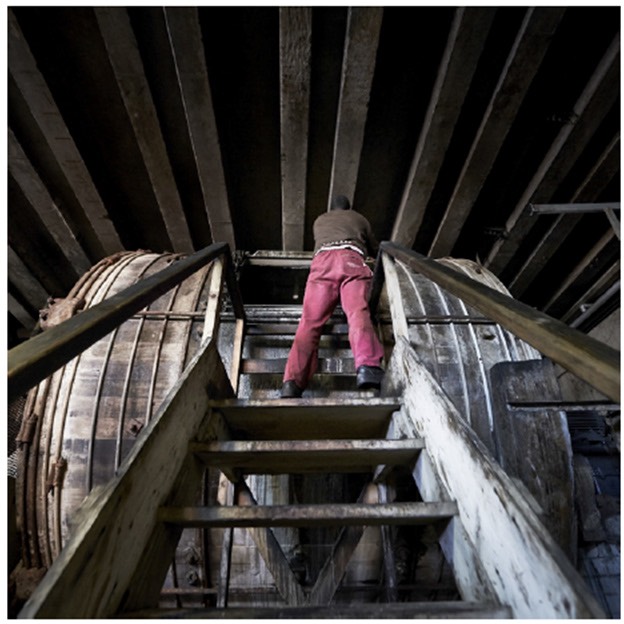
Drum-tanning cowhides in Tuscany
"Many of the substances used during the tanning process are recovered, recycled and reused in different fields. Hair removed from raw hides is transformed into agricultural fertilizer; sludge produced by the depuration plants is reused in the construction field to make bricks.
Vegetable-tanned leather absorbs the traces of our life, it matures, it tans under the sun, it reveals the signs of time and use as the most personal expression of naturalness and truth.”
Hide and skin production around the world
The entire epidermal layer of your skin turns over every 48 days
Begun December 2015
